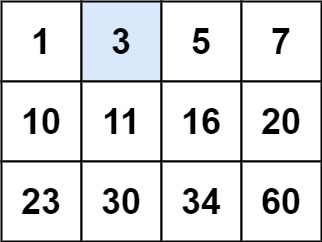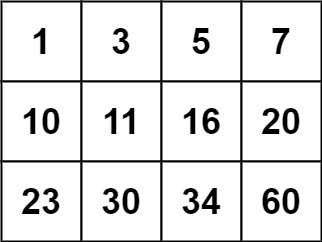Search a 2D Matrix
MediumYou are given an m x n integer matrix matrix with the following two properties:
- Each row is sorted in non-decreasing order.
- The first integer of each row is greater than the last integer of the previous row.
Given an integer target, return true if target is in matrix or false otherwise.
You must write a solution in O(log(m * n)) time complexity.
Example 1:

Input: matrix = [[1,3,5,7],[10,11,16,20],[23,30,34,60]], target = 3 Output: true
Example 2:

Input: matrix = [[1,3,5,7],[10,11,16,20],[23,30,34,60]], target = 13 Output: false
Constraints:
m == matrix.lengthn == matrix[i].length1 <= m, n <= 100-104 <= matrix[i][j], target <= 104
Solution
Clarifying Questions
When you get asked this question in a real-life environment, it will often be ambiguous (especially at FAANG). Make sure to ask these questions in that case:
- What are the constraints on the dimensions m and n of the matrix? Could either be zero?
- What is the range of integer values within the matrix and for the target? Could they be negative?
- Is it guaranteed that each row is sorted in non-decreasing order, and that the first integer of each row is greater than the last integer of the previous row?
- If the matrix is empty (m=0 or n=0), what should I return?
- Are there any memory constraints I should be aware of?
Brute Force Solution
Approach
Imagine a grid of numbers and you need to find a specific target number. The brute force approach means we will look at every single number in the grid, one by one. We'll keep checking until we either find the target or run out of numbers to check.
Here's how the algorithm would work step-by-step:
- Start by looking at the very first number in the grid.
- Check if this number is the number we're looking for.
- If it is, we're done! We found it.
- If not, move to the next number in the grid, going row by row.
- Keep checking each number to see if it matches our target number.
- If we reach the end of the grid without finding the number, then the number is not in the grid.
Code Implementation
def search_matrix_brute_force(matrix, target):
number_of_rows = len(matrix)
number_of_cols = len(matrix[0])
for row_index in range(number_of_rows):
# Iterate through each row.
for col_index in range(number_of_cols):
# Iterate through each column in current row.
if matrix[row_index][col_index] == target:
#If target is found return True
return True
# If target not found in the matrix.
return FalseBig(O) Analysis
Optimal Solution
Approach
The trick is to treat the 2D matrix like one long, sorted list, even though it's shaped like a rectangle. This lets us use a very efficient search method similar to how you'd find a word in a dictionary.
Here's how the algorithm would work step-by-step:
- Imagine the matrix is a single sorted sequence of numbers. Figure out where the 'middle' number of the entire sequence would be located within the 2D matrix.
- Compare the number you're searching for with the number you found in the 'middle'.
- If the number you're searching for is smaller than the 'middle' number, you know it must be in the first half of the imaginary list. Discard the entire second half of the matrix from your search.
- If the number you're searching for is larger than the 'middle' number, you know it must be in the second half of the imaginary list. Discard the entire first half of the matrix from your search.
- Repeat this process of finding the middle and comparing, each time narrowing down the search area by half. Keep going until you either find the number or the search area becomes empty.
- If the search area becomes empty, it means the number isn't in the matrix.
Code Implementation
def search_2d_matrix(matrix, target):
if not matrix or not matrix[0]:
return False
number_of_rows = len(matrix)
number_of_columns = len(matrix[0])
left_pointer = 0
right_pointer = number_of_rows * number_of_columns - 1
while left_pointer <= right_pointer:
middle_element = (left_pointer + right_pointer) // 2
row_index = middle_element // number_of_columns
column_index = middle_element % number_of_columns
middle_value = matrix[row_index][column_index]
# Adjust search space based on middle value
if target == middle_value:
return True
# Narrow search to the left half
elif target < middle_value:
right_pointer = middle_element - 1
# Narrow search to the right half
else:
left_pointer = middle_element + 1
return FalseBig(O) Analysis
Edge Cases
| Case | How to Handle |
|---|---|
| matrix is null or empty | Return false immediately, as there are no elements to search. |
| matrix has zero rows or zero columns | Return false immediately, as there are no elements to search. |
| matrix contains only one row | Binary search this single row to find the target. |
| matrix contains only one column | Binary search the first element of each row to find the target. |
| target is smaller than the smallest element in the matrix | Return false since the matrix is sorted in non-decreasing order. |
| target is larger than the largest element in the matrix | Return false since the matrix is sorted and cannot contain the target. |
| Large matrix dimensions that could lead to integer overflow in calculations of indices | Use long integers or alternative formulas that avoid overflow for index calculations, if necessary. |
| target equals to the first element of a row | Algorithm should return true once the first element is the target value |